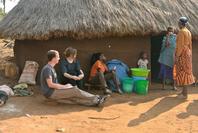Successful Trip to Tanzania for Water Harvesting GDT
Endallah is located in the semi-arid region of Arusha and faces water stress during the dry season from May to October. Many people in the community have to walk several hours daily to collect enough water for domestic use.
Sand dams are constructed across seasonal rivers where sand is accumulated upstream of the dam. This allows water to be stored in the subsurface reservoir created by the sand. Sand dams can provide large quantities of water for a long period of time in semi-arid regions like Endallah because of reduced evaporation rates. The team has focused work in three main areas: understanding sand dam design criteria, modelling local hydraulics with GIS software, and considering social impacts of the project.
By taking the time to understand the many dimensions of community-based water harvesting, the team’s multidisciplinary approach will ensure a design which is both technically and socially feasible.
In January 2015, two students from the Global Development Team, Marisa Henry (EEE) and Garrett Quathamer (Anthropology), travelled with faculty advisor, Professor Venkatesh Merwade (CE), to Arusha, Tanzania to visit the community of Endallah. The trip was made possible through funding from the Purdue Center for Global Food Security Student Innovation Grant received during spring 2014. The goal of the trip was to collect qualitative and quantitative information needed to recommend a viable dam location and size.
During the trip, the team was able to conduct a survey of community water use habits and collaborated with a recent Master’s student graduate from NM-AIST, Anna Msigwa, to receive additional GIS data for Endallah. The students also visited local water sources to understand current systems used and their relative successes and failures in Endallah. Finally, the team built relationships with community leaders and partners at the NM-AIST.
While in Endallah, the team discovered Endallah’s seasonal stream’s banks are unstable, so bank stabilization techniques will be researched. The team plans to have a dam location and size recommendation by the end of the semester. During the trip, it also became apparent that there are huge areas for improvement in several existing water sources in the area. The team will begin research on simple, sustainable technologies that can be used to enhance these sources.
Looking forward, the team plans to send several students back to Tanzania during Summer 2015 under the Hydrologists Helping Others (H2O) Grant received. The team will continue to build relationships with the NM-AIST and hopes to present the work completed this semester and collaborate with the community on finalizing a dam location.


